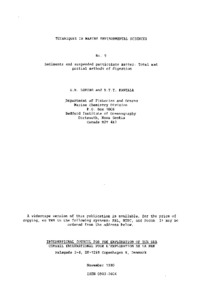| dc.contributor.author | Loring, D. H. | |
| dc.contributor.author | Rantala, R.T.T. | |
| dc.date.accessioned | 2019-01-15T22:36:19Z | |
| dc.date.available | 2019-01-15T22:36:19Z | |
| dc.date.issued | 1990 | |
| dc.identifier.citation | Loring, D.H. and Rantala, R.T.T. (1990) Sediments and suspended particulate matter: Total and partial methods of digestion. ICES Techniques in Marine Environmental Sciences, No. 9, 14pp. DOI: http://dx.doi.org/10.25607/OBP-245 | en_US |
| dc.identifier.issn | 0903–2606 | |
| dc.identifier.uri | http://hdl.handle.net/11329/688 | |
| dc.identifier.uri | http://dx.doi.org/10.25607/OBP-245 | |
| dc.description.abstract | In
order
to
determine
the
major
and
trace
metal
concentrations
of
marine
sediments
and
suspended
particulate
matter
by
wet
chemical
methods,
it
is
necessary
to
dissolve
all
or
part
of
the
sample.
Sample
digestion
methods
commonly
used
are:
(a)
total
decomposition,
(b)
strong
acid
digestion,
or
(c)
moderate
or
weak
acid
extractions.
This
leaflet
describes
in
detail
the
wet
chemical
methods
for
both
total
decomposition
and
weak
acid
extraction
of
sediments
and
suspended
particulate
matter. | |
| dc.language.iso | en | en_US |
| dc.publisher | International Council for the Exploration of the Sea (ICES) | en_US |
| dc.relation.ispartofseries | ICES Techniques in Marine Environmental Sciences; 9 | |
| dc.title | Sediments and suspended particulate matter: Total and partial methods of digestion. | en_US |
| dc.type | Report | en_US |
| dc.description.status | Published | en_US |
| dc.format.pages | 14pp. | en_US |
| dc.description.refereed | Refereed | en_US |
| dc.publisher.place | Copenhagen, Denmark | en_US |
| dc.description.currentstatus | Current | en_US |
| dc.description.eov | Particulate matter | |
| dc.description.bptype | Standard Operating Procedure | en_US |
| dc.description.bptype | Guide | en_US |
| obps.contact.contactemail | info@ices.dk | |
| obps.resourceurl.publisher | http://ices.dk/publications/library/ | en_US |
 Repository of community practices in Ocean Research, Applications and Data/Information Management
Repository of community practices in Ocean Research, Applications and Data/Information Management
